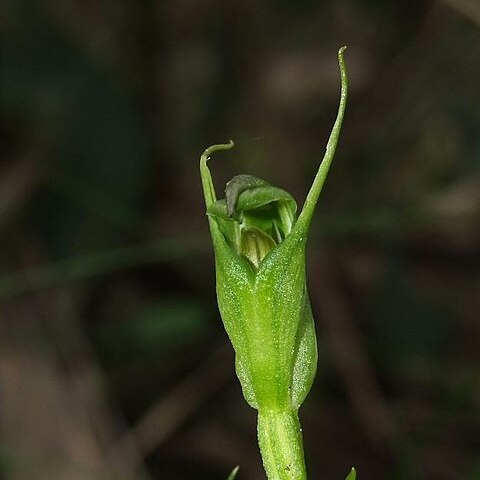Plant c. 15–40 cm. tall. Stem c. 2 mm. diam., in some plants sparsely and unevenly puberulous; upper internodes us. longer than stem lvs. Lower lvs us. crowded but not forming well-defined rosette; lamina to c. 5 × 1 cm., often shorter, elliptic, subacute, gradually narrowed into short, winged petiole. Cauline lvs 1–2, often 2–3 cm. long, ± foliaceous, sheathing, the uppermost sts reaching but rarely overtopping fl. Fl. solitary, erect. Dorsal sepal c. 2 cm. tall, apex acute and ± horizontal; lateral sepals papillose on the connate portion (as is the ovary), diverging at a narrow angle, tips caudate and overtopping galea. Petals only a little shorter than dorsal sepal, broad almost to tip. Labellum narrow-triangular, arched and protruding, apex narrowly obtuse, margins slightly upturned. Column shorter than labellum; stigma elliptic, slightly prominent.
Leaves 3–6, scattered loosely up stem, 30–120 x 14–22mm, obliquely erect, dark green, fleshy, margins usually crinkled. Flower stem 150–35 tall, slender, smooth or scabrous. Flower erect, 16–22 x 7–9mm, translucent white and dark green, apex often brown to dark brown. Dorsal sepal about as long as petals, usually decurved, tapered to short point. Lateral sepals with narrow side gap. Sinus curved in side view, strongly scabrous, broadly notched in front view. Free points filiform, 15–1 long, erect, often incurved, reaching high above hood. Petals narrow, scabrous, shortly pointed. Labellum curved forwards near apex, tip protruding above sinus when set; lamina oblong to oblong-lanceolate, 9–11 x 2.5–3mm, brown, blunt.
Leaves 3–4, in loose basal rosette with one or two sheathing stem bracts, 30–80 x 10–16mm, dark green, fleshy, margins smooth or crinkled. Flower stem 8–15 tall, slender, smooth. Flower stiffly erect, plump, chunky, 17–20 x 7–9mm, green and translucent white. Dorsal sepal about as long as petals, tapered to short point. Lateral sepals closely embracing petals or with narrow side gap. Sinus nearly flat in side view, broadly notched in front view. Free points thickish, narrowly tapered, 10–1 long, erect or slightly recurved, extending above hood. Petals narrow, smooth, shortly pointed. Labellum curved near apex, protruding from sinus when set; lamina oblong, 10–12 x 2–3mm, green to brown, blunt.

